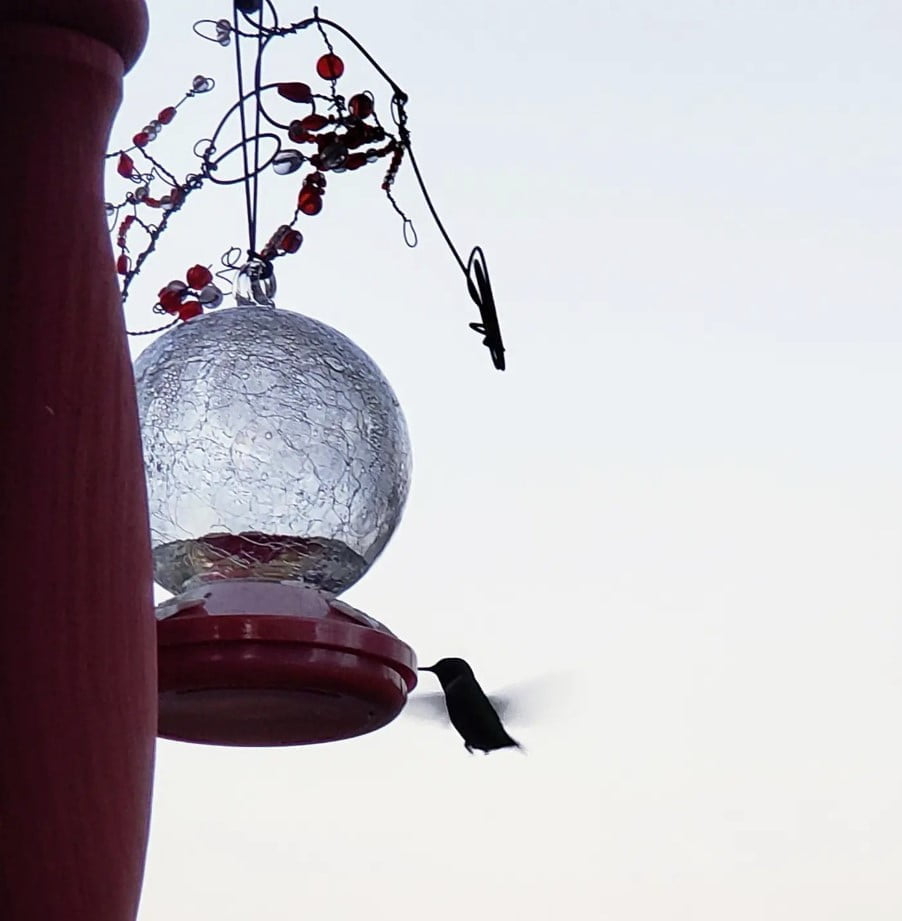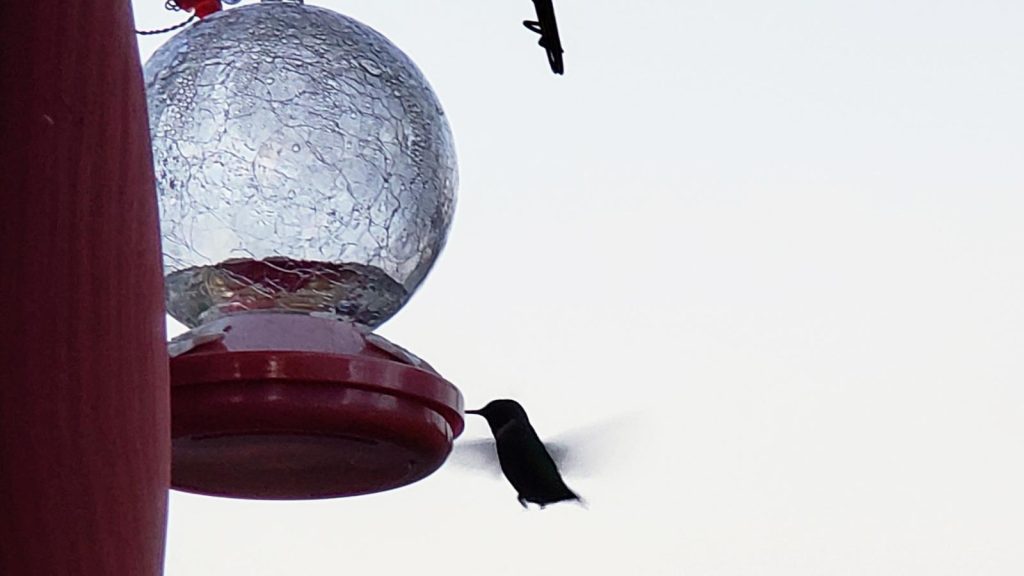Are you curious about the remarkable ability of how hummingbirds to find feeders in seemingly remote areas? Despite their tiny size, these incredible birds possess an astonishing sense of direction and an uncanny knack for finding food sources, even in the middle of nowhere.
It’s that time of the year again in Western Maine where the Hummingbirds are coming to visit us up north.
Understanding the mechanisms behind this remarkable feat can shed light on the fascinating world of hummingbird behavior and navigation.
In this blog post, we will explore how hummingbirds find feeders in seemingly inaccessible locations.
Hummingbirds’ Incredible Navigational Abilities
Hummingbirds are known for their remarkable navigational abilities, allowing them to find feeders even in the most remote locations. These tiny birds possess unique skills that enable them to navigate with precision and locate food sources efficiently.
From exceptional visual acuity to sensing the Earth’s magnetic field, hummingbirds showcase a range of remarkable capabilities.
How Do Hummingbirds Find Feeders: Exceptional Visual ability
One of the key factors contributing to hummingbirds’ extraordinary navigational skills is their exceptional visual ability. Despite their small size, these birds have incredibly sharp eyesight, allowing them to spot minute details from impressive distances.
Their keen vision enables them to detect vibrant-colored flowers and feeders from afar, even in dense vegetation. Vision is key to how do hummingbirds find feeders in the middle of nowhere.
Hummingbirds can perceive a wide spectrum of colors, including ultraviolet light, which humans cannot see. This expanded color range helps them identify nectar-rich flowers and feeders accurately.
Hummingbirds and other kite birds can swiftly assess their surroundings, recognize potential food sources, and navigate towards them with precision.
Sensing Earth’s Magnetic Field
In addition to their impressive visual abilities, hummingbirds also can sense the Earth’s magnetic field. This remarkable skill, known as magnetoreception, allows them to navigate and orient themselves during long-distance migrations.
Similar to a natural compass, hummingbirds can detect the Earth’s magnetic field lines and use them as a reference point while flying. This helps them determine their direction and maintain a consistent flight path, even when they encounter unfamiliar territories.
Scientists believe that hummingbirds may utilize tiny iron-containing structures in their beaks or inner ears to sense the Earth’s magnetic field. While the exact mechanisms of magnetoreception in hummingbirds are still being studied, their ability to navigate accurately over vast distances is undoubtedly a testament to their extraordinary navigational skills.
I wonder how the recent solar storms affect them.
Long-Distance Migration Patterns
Hummingbirds are renowned for their incredible long-distance migration patterns. These tiny birds possess a remarkable ability to navigate vast distances to find food sources, even in seemingly remote locations.
Let’s explore two key factors that contribute to their extraordinary migratory journeys and how hummingbirds find feeders in the middle of nowhere.
Internal Clocks and Seasonal Changes
Hummingbirds, like many other migratory birds, have internal clocks that are finely attuned to seasonal changes. This internal clock acts as a biological compass, guiding them on their migratory routes.
As the seasons change, these birds can sense the subtle variations in day length and temperature, signaling them to begin their migratory journey.
During the breeding season, hummingbirds take advantage of the abundance of food sources in their breeding grounds. As the seasons shift and resources become scarce, their internal clocks trigger the instinct to start their long migration in search of more favorable feeding grounds.
Familiarity With Routes Helps Hummingbirds Find Feeders
One of the most fascinating aspects of hummingbird migration is their ability to remember and follow specific routes year after year. These routes, known as flyways, are ingrained in their genetic memory and passed down through generations.
Hummingbirds rely on their innate navigation skills to traverse these well-established pathways.
Through observation and experience, hummingbirds become familiar with the landmarks, geographical features, and ecological cues along their migration routes. They can remember the location of reliable food sources such as nectar-rich flowers and feeders.
This familiarity allows them to navigate even the most remote areas with precision, finding feeders seemingly in the middle of nowhere.

Extraordinary Memory Skills
Hummingbirds are known for their incredible memory skills, which play a crucial role in their ability to find feeders even in the middle of nowhere.
These tiny birds possess an exceptional capacity to remember feeder locations and navigate their surroundings with astonishing accuracy.
Let’s explore two fascinating aspects of their memory skills: remembering feeder locations and spatial mapping abilities.
How Do Hummingbirds Find Feeders Quickly: By Remembering Feeder Locations
Hummingbirds have an uncanny ability to remember the precise locations of feeders they have visited before. Despite their small size, they can quickly learn and recall the position of each feeder, even when placed in vast and unfamiliar territories.
This remarkable memory allows them to establish efficient feeding routes and revisit reliable food sources throughout their migration journeys.
Their memory is not limited to short-term recollection but extends to long-term retention as well. Research has shown that hummingbirds can remember feeder locations for months, allowing them to return to the same spots year after year.
This impressive memory capacity enables them to maintain access to vital nectar resources, ensuring their survival and successful breeding.
How Do Hummingbirds Find Feeders? Spatial Mapping Abilities Help
In addition to remembering specific feeder locations, hummingbirds possess exceptional spatial mapping abilities. They can mentally create detailed mental maps of their surroundings without getting lost, even when flying through complex and diverse landscapes.
Hummingbirds use a combination of visual cues, landmarks, and environmental features to navigate their surroundings. By mentally mapping their environment, they can identify and recognize familiar territories, feeding hotspots, and potential threats.
This spatial awareness is crucial for their survival, especially when exploring unfamiliar territories or searching for scarce resources.
Their spatial mapping abilities also help them track the movement of seasonal flowers and the availability of nectar sources, allowing them to adapt their migration patterns and flowering preferences accordingly.
This adaptive behavior showcases the depth and complexity of their memory and spatial cognition.
Keen Sense of Smell
Hummingbirds possess an extraordinary ability when it comes to finding feeders in seemingly remote locations. One fascinating aspect of their navigation skills is their keen sense of smell.
This section will explore how hummingbirds detect nectar from a distance and recognize familiar scents.
How Do Hummingbirds Find Feeders by Detecting Nectar From A Distance?
Despite their diminutive size, hummingbirds have an astonishing capability to detect the scent of nectar from considerable distances. Their olfactory senses are highly developed, allowing them to pick up on the faintest traces of fragrances emanating from flowers or feeders.
This acute sense of smell helps guide them towards potential food sources, even in unfamiliar territories.
When a hummingbird catches a whiff of nectar in the air, it can quickly zero in on the source with precision. This is particularly impressive considering the vast spaces these small birds traverse during their migratory journeys.
With the help of their olfactory prowess, they can cover great distances while efficiently locating the necessary fuel for their high-energy lifestyles.
Recognizing Familiar Scents
In addition to detecting nectar from a distance, hummingbirds also possess the ability to recognize familiar scents. Once a hummingbird has found a reliable food source, it can imprint the scent of that location and use it as a reference point for future visits.
This means that if a feeder is placed in the same spot consistently, the hummingbirds will remember the scent associated with it.
The ability to recognize familiar scents allows hummingbirds to revisit known feeding spots with ease, even if those locations are hidden deep within a vast landscape.
By leveraging their keen sense of smell, hummingbirds can overcome the perplexity of finding feeders in the middle of nowhere. Their ability to detect nectar from a distance and recognize familiar scents showcases their incredible navigational skills and resourcefulness in securing sustenance.
Imagine possessing such an acute sense of smell that you can effortlessly pinpoint the aroma of something you desire from miles away. It’s truly awe-inspiring to consider the abilities of these remarkable creatures.
Learning From Other Hummingbirds
One fascinating aspect of hummingbirds is their ability to learn from one another.
These tiny creatures possess a remarkable capacity for observation and communication when it comes to finding feeders in seemingly remote locations.
How Do Hummingbirds Find Feeders By Observing Feeding Behaviors?
Hummingbirds are keen observers of their surroundings, including the feeding behaviors of their counterparts. When a hummingbird spots another bird successfully feeding from a feeder, it quickly registers this behavior as a potential source of nourishment.
They meticulously observe the actions of the feeder-visiting bird, taking note of its approach, feeding techniques, and the general location of the feeder.
By carefully watching and learning from other hummingbirds, they gain valuable information about the availability and accessibility of feeding resources. This observational learning helps them expand their foraging territory and discover new feeders, even in the middle of nowhere.
Following Signals and Cues
Hummingbirds also communicate with one another through signals and cues, which aid in their search for feeders. These signals can take various forms, such as distinct vocalizations, specific flight patterns, or even visual displays.
When a hummingbird discovers a feeder, it may emit a unique chirping sound or perform a specific flight maneuver to signal its findings to nearby hummingbirds.
Other hummingbirds in the vicinity pick up on these signals and cues, recognizing them as indications of a food source. This communication network enables hummingbirds to share information about the location and availability of feeders, reducing the time and energy required for individual exploration.
By following these signals and cues, hummingbirds can navigate through unfamiliar territories, relying on the knowledge and guidance of their fellow species members to find feeders even in the most remote areas.
Wrapping Up: How Do Hummingbirds Find Feeders Anywhere?
In conclusion, the ability of hummingbirds to find feeders in the middle of nowhere is truly remarkable. It is a result of their exceptional visual and cognitive abilities.
These tiny birds rely on their keen eyesight and memory to navigate through vast distances in search of nectar-rich flowers and feeders. By using landmarks, shapes, colors, and patterns, they can create mental maps and find their way back to reliable food sources, even in unfamiliar territory.
Hummingbirds also possess an incredible sense of smell, which helps them detect the fragrant aroma of nectar from a considerable distance. This olfactory sense, combined with their visual acuity, allows them to home in on feeders that may otherwise seem invisible to us.
Understanding these remarkable qualities can help us appreciate and create better environments to attract and support these incredible tiny creatures. Did you know how hummingbirds find feeders quickly before reading this blog post?
Our Hummingbirds
We hadn’t seen any until we moved into our rural home 4 years ago. However, we do leave the water with a few tablespoons of sugar in their feeders so they can come back to feed throughout the warmer months.
Do you have water with sugar to get hummingbirds to your yard? I’d love to hear from you in the comment below.




